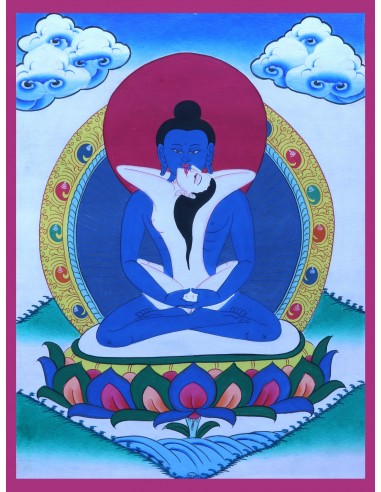14.5"X11" Samantabhadra Kuntuzangpo Thangka Painting
This thangka was painted by a master thangka artist in the traditional style, and it is of high quality.
| Name | : Samantabhadra Thangka Painting |
| Mantra | : 'Om Samantabhadraya Namah' |
| Dimension | : 45"x22" inches approx. (With Brocade) |
| Dimension | : 15"x11" inches approx. (Without Brocade) |
| Color | : Mineral, and vegetable pigment |
| Material | : Cotton Canvas, and Pure Gold Detail |
| Design | : Buddhism and Tibetan Thangka Painting |
| : Wall Hanging OR Frame Home Decor | |
| Origin | : Handmade in Nepal |
| Time to Make | : Ready to Ship |
Samantabhadra is a bodhisattva in Mahayana Buddhism that represents the practice of meditation and the ultimate nature of reality. A thangka is a Tibetan Buddhist painting on cotton or silk that depicts various deities, bodhisattvas, and other spiritual figures. A Samantabhadra thangka typically shows the bodhisattva sitting on a lotus throne and holding his consort Samantabhadri in this thangka painting. His skin is blue, and he is sitting in the "vajra" position with his two hands in his lap in a sign of meditation. Samantabhadra is usually depicted with a peaceful expression. Samantabhadra is considered to be one of the most important bodhisattvas in Mahayana Buddhism and is revered for his commitment to practicing virtue and helping others achieve enlightenment. Thangka depicting Samantabhadra is often used in meditation practices and as an object of devotion in Tibetan Buddhist temples and households. Samantabhadra's name means "all-good" or "ever-perfect," and he is regarded as the embodiment of the qualities of Buddhahood, including wisdom, compassion, and skillful means. He is also associated with the primordial state of pure awareness, which is the basis of all phenomena and the ultimate nature of reality. According to Buddhist scriptures, Samantabhadra made a vow to work for the benefit of all sentient beings and to lead them to enlightenment. He is often depicted together with his consort, Samantabhadri, who represents the aspect of primordial wisdom. In the Dzogchen tradition, Samantabhadra is considered the ultimate source of all teachings and practices, and the pinnacle of the spiritual path. Practitioners of Dzogchen aspire to realize the nature of Samantabhadra, which is described as the state of non-dual awareness beyond conceptualization or effort.
Samantabhadra is also associated with the practice of bodhisattva activity, which involves cultivating the aspiration to attain enlightenment for the benefit of all sentient beings. He represents the ultimate goal of this practice, which is to attain the state of Buddhahood and to work tirelessly for the benefit of others.
------------------------------------------------------------------------------------------------------------------------------------------------
* Thangka's Border (Tibetan silk brocade) can come in a variety of colors and patterns.
Note: The actual color of the products may slightly differ due to the photographic edits.






























